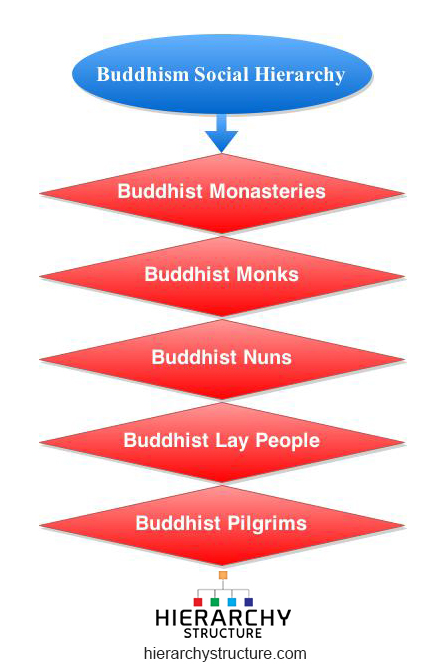Buddhism is one of the most widespread religions in the world which was initiated by Siddhartha Gautama. It is one of the most prominent religions spread over India and major parts of Asia including Burma, Thailand, Sri Lanka, Korea, Japan and Taiwan. The Buddhist social hierarchy is centred on the ‘Sanghas’ or ‘order of disciplines’.
The Sanghas are the groups of Monks, who convey the instructions of Buddha across the world. The monks are usually based in monasteries, where they teach students to spread their teachings all over the world. Given below are the details of Buddhism social hierarchy:
 Buddhist Monasteries
Buddhist Monasteries
The Buddhist Monasteries are home to those people who devote their life entirely to Buddhist religion. These monasteries are the learning centres of the religion and most Buddhist children go there to study about the religion. The monastery is open to public and common people can stay there for a limited period of time. The monks are the teachers here who teaches about Buddha’s principals and the religion as a whole.
Monks reside in the monasteries spending their time in teaching and meditation with chants and prayers. A monastery is usually inclusive of school rooms, prayer halls, crematorium, library and dormitories. It is run by donations, support from local community and money gained from ceremonies.
Buddhist Monks
The Buddhist monks are the highest group in the social hierarchy of Buddhism. They are the most respected and valued in the community. They usually live together in Buddhist monasteries where they teach the students. Their time is spent in teaching, meditation and chanting prayers in the monastery.
Buddhist Nuns
The next class in the Buddhist social hierarchy is the nuns who are usually the assistants to the monks. Women can also become nuns and they handle the less responsible jobs in the monastery. They are generally involved in meditation and prayers most of the time.
Buddhist Lay People
There is a symbolic idyllic relationship exists between the common Buddhist people and their monks. The lay people provide the monks all their necessary things for their day to day life including food, shelter and medicines. They are really generous to take care of each and every requirement of the monks and in return the monks teach them about Buddhist religion. The lay people spend their time in earning their living occupied in a variety of professions like any other community. Though they learn about Buddhist principles, they spend less time in meditation and prayers.
Buddhist Pilgrims
The Buddhist pilgrims form the lower end of their social hierarchy. These people are Buddhist believers from multiple places who are travelling from one location to the other in search of knowledge. The travel destinations include religiously significant place like Buddha’s birthplace or the locations of famous stupas. The pilgrims who are wandering from one place to another usually come to the Buddhist monastery in their place of visit. They stay in the monasteries and learn about the Buddhist principles and the religion in depth.
